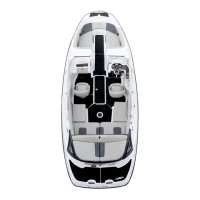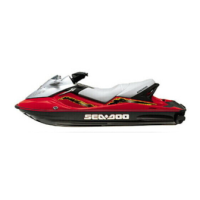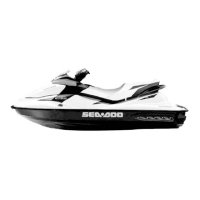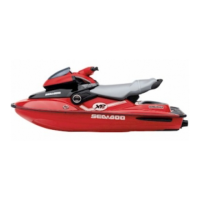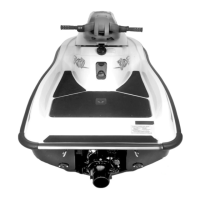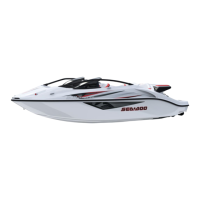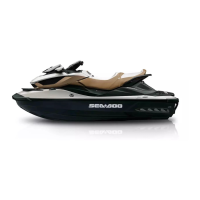Do you have a question about the Sea-doo 230 Series and is the answer not in the manual?
Essential sections to read before operating the boat for accident risk reduction.
Explanation of safety message types, their appearance, and usage within the guide.
Purpose of the guide in acquainting owners with controls, maintenance, and safe operation.
Key safety reminders regarding boat operation, including CO risks and gasoline vapor awareness.
Information on mandatory and recommended safety equipment, including PFDs and fire extinguishers.
Guidance on practicing boat controls, handling, and maneuvers before venturing out.
Guidelines for safe operation, including awareness of drugs/alcohol and passenger safety.
Essential rules for operating a boat, including right-of-way and signaling.
Detailed overview of boat controls, including cockpit layout and individual switch functions.
Explanation of the information center's displays and functions, including gauges and system modes.
Guide to navigating the touchscreen display, modes, and audio system functions.
Description and function of analog gauges like temperature, fuel level, and voltmeter.
Details on analog gauges specific to the 230 Wake model, including speedometer.
Overview of boat components and features, including seats, storage, and accessories.
Instructions for the initial 10-hour break-in period to ensure engine longevity and performance.
Safe procedures for boarding the boat from a dock or in shallow/deep water.
Step-by-step guide for starting the boat's engines, including pre-ride checks and tether cord usage.
How the steering wheel controls the boat's direction and the importance of throttle for turning.
Instructions for operating the throttle and shifter for forward, neutral, and reverse.
Advice for operating in rough water, at night, crossing waves, stopping, and docking.
Explanation and activation of the Cruise Mode for maintaining steady boat speed.
Details on the Ski Mode for adjusting launch intensity and target speed for water sports.
Information on the ECO Mode for optimizing fuel efficiency by limiting engine torque.
How to engage the Docking Mode for increased maneuverability during docking.
Procedure for cleaning the jet pump intake and impeller to prevent damage.
Precautions and procedures for towing the Sea-Doo boat in water.
Steps to limit engine damage after a boat has been submerged.
Recommended dealer check after the first 10 hours of operation.
Regular maintenance tasks based on hours of use or time intervals.
Instructions for basic maintenance tasks like engine oil and coolant changes.
Essential steps after operation, including rinsing and anticorrosion treatment for saltwater use.
Guidance on cleaning the engine compartment, body, and specific surfaces.
Instructions for cleaning the boat's exterior, including fiberglass and plastic parts.
How to protect the fuel system for storage using stabilizers.
Procedure to flush exhaust systems and intercoolers to prevent corrosion.
Steps for lubricating engine cylinders for storage.
Locating Hull Identification Number (HIN) and Engine Identification Number (EIN).
Details on emissions control, manufacturer, dealer, and owner responsibilities.
Technical data for engines, cooling, electrical, fuel system, propulsion, and dimensions.
Diagnosing common boat problems and their potential solutions.
Understanding the engine monitoring system and beeper codes for fault alerts.
Terms and conditions of the limited warranty for Sea-Doo boats in USA and Canada.
Specific emission control warranty for California models with 4-TEC engines.
Warranty details for Sea-Doo boats sold internationally, including Europe and Russia.
Warranty terms for Sea-Doo boats in European, Russian, and Turkish markets.
Information on how BRP uses and protects customer data.
Procedures for notifying BRP of address changes or ownership transfers.
Essential sections to read before operating the boat for accident risk reduction.
Explanation of safety message types, their appearance, and usage within the guide.
Purpose of the guide in acquainting owners with controls, maintenance, and safe operation.
Key safety reminders regarding boat operation, including CO risks and gasoline vapor awareness.
Information on mandatory and recommended safety equipment, including PFDs and fire extinguishers.
Guidance on practicing boat controls, handling, and maneuvers before venturing out.
Guidelines for safe operation, including awareness of drugs/alcohol and passenger safety.
Essential rules for operating a boat, including right-of-way and signaling.
Detailed overview of boat controls, including cockpit layout and individual switch functions.
Explanation of the information center's displays and functions, including gauges and system modes.
Guide to navigating the touchscreen display, modes, and audio system functions.
Description and function of analog gauges like temperature, fuel level, and voltmeter.
Details on analog gauges specific to the 230 Wake model, including speedometer.
Overview of boat components and features, including seats, storage, and accessories.
Instructions for the initial 10-hour break-in period to ensure engine longevity and performance.
Safe procedures for boarding the boat from a dock or in shallow/deep water.
Step-by-step guide for starting the boat's engines, including pre-ride checks and tether cord usage.
How the steering wheel controls the boat's direction and the importance of throttle for turning.
Instructions for operating the throttle and shifter for forward, neutral, and reverse.
Advice for operating in rough water, at night, crossing waves, stopping, and docking.
Explanation and activation of the Cruise Mode for maintaining steady boat speed.
Details on the Ski Mode for adjusting launch intensity and target speed for water sports.
Information on the ECO Mode for optimizing fuel efficiency by limiting engine torque.
How to engage the Docking Mode for increased maneuverability during docking.
Procedure for cleaning the jet pump intake and impeller to prevent damage.
Precautions and procedures for towing the Sea-Doo boat in water.
Steps to limit engine damage after a boat has been submerged.
Recommended dealer check after the first 10 hours of operation.
Regular maintenance tasks based on hours of use or time intervals.
Instructions for basic maintenance tasks like engine oil and coolant changes.
Essential steps after operation, including rinsing and anticorrosion treatment for saltwater use.
Guidance on cleaning the engine compartment, body, and specific surfaces.
Instructions for cleaning the boat's exterior, including fiberglass and plastic parts.
How to protect the fuel system for storage using stabilizers.
Procedure to flush exhaust systems and intercoolers to prevent corrosion.
Steps for lubricating engine cylinders for storage.
Locating Hull Identification Number (HIN) and Engine Identification Number (EIN).
Details on emissions control, manufacturer, dealer, and owner responsibilities.
Technical data for engines, cooling, electrical, fuel system, propulsion, and dimensions.
Diagnosing common boat problems and their potential solutions.
Understanding the engine monitoring system and beeper codes for fault alerts.
Terms and conditions of the limited warranty for Sea-Doo boats in USA and Canada.
Specific emission control warranty for California models with 4-TEC engines.
Warranty details for Sea-Doo boats sold internationally, including Europe and Russia.
Warranty terms for Sea-Doo boats in European, Russian, and Turkish markets.
Information on how BRP uses and protects customer data.
Procedures for notifying BRP of address changes or ownership transfers.

